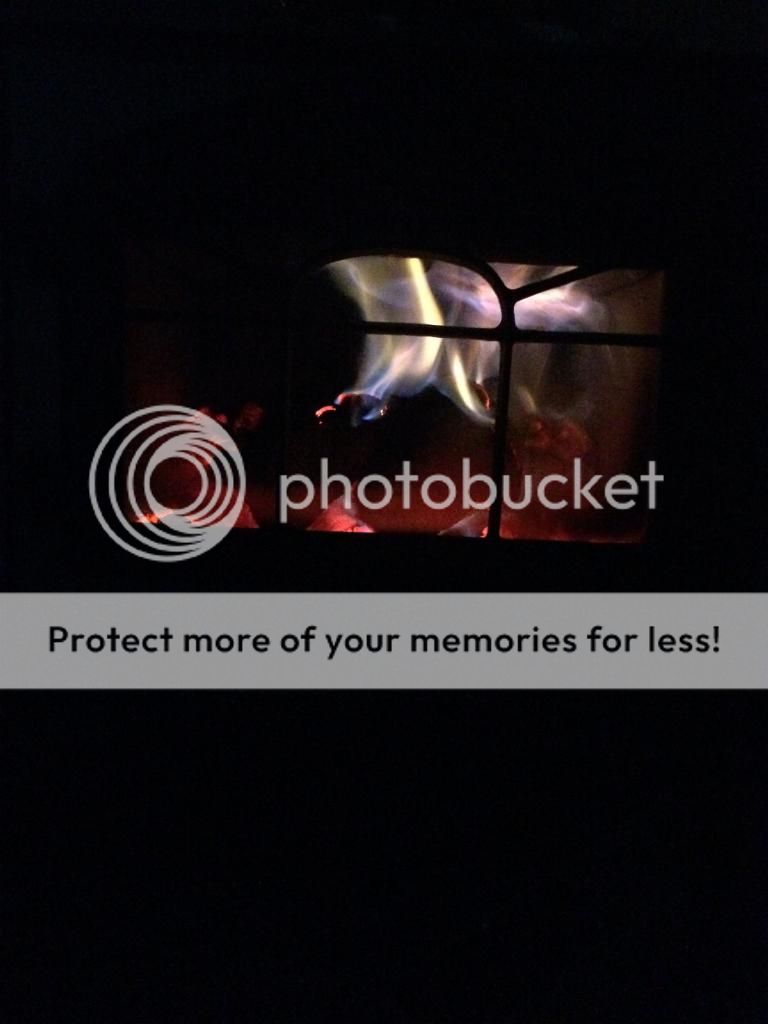Yay! Stove finally all installed, and fired up! First note, phew, stinky! Also, another note, if you have an over sensitive fire alarm right above the stove be prepared to be deafened, or receive a load of angry texts from the wife...cause she can't reach it to take it down...apparently an hour of a fire alarm blaring can make a person a bit nutty! 
So we put a mixed load of softwood and hardwood in about 2pm, my wife said it was hard to get the first fire going, but she managed it and had the flue temp up to 600 in short order. She let that burn down to coals, then when I got home I raked out the coals and stuffed in a large red cedar crotch (barely fit in stove) and let that burn. The cedar never got the flue temp above about 450, and seemed to hover between 350-400 really. At about 11pm it was still in one piece but easily broke apart into a bed of glowing coals. I put 3 medium sized splits in the stove and within 20 minutes I had this and went to bed:

...last nights outside temp was 3 degrees C (37F), I woke up at 7am and noticed right away that it didn't feel cold, but just about right (2nd floor bedroom as far from stove as possible in house). So I went downstairs. The flue temp probe was sitting at 200 and there was a large bed of glowing coals under the ashes. The temp in the house was 21.7 Celsius (71F). Considering the furnace is set much lower then that, it was all wood heat last night. I loaded the stove up (two birch splits EW load, 5 maple NS load. Close the door with draft full open. Within 20 minutes again had flue temp at 500 and began closing draft. 30 minutes draft full closed and temp at 600! So much for difficult break in period!
Bring on winter! I got it covered!
Ian

So we put a mixed load of softwood and hardwood in about 2pm, my wife said it was hard to get the first fire going, but she managed it and had the flue temp up to 600 in short order. She let that burn down to coals, then when I got home I raked out the coals and stuffed in a large red cedar crotch (barely fit in stove) and let that burn. The cedar never got the flue temp above about 450, and seemed to hover between 350-400 really. At about 11pm it was still in one piece but easily broke apart into a bed of glowing coals. I put 3 medium sized splits in the stove and within 20 minutes I had this and went to bed:

...last nights outside temp was 3 degrees C (37F), I woke up at 7am and noticed right away that it didn't feel cold, but just about right (2nd floor bedroom as far from stove as possible in house). So I went downstairs. The flue temp probe was sitting at 200 and there was a large bed of glowing coals under the ashes. The temp in the house was 21.7 Celsius (71F). Considering the furnace is set much lower then that, it was all wood heat last night. I loaded the stove up (two birch splits EW load, 5 maple NS load. Close the door with draft full open. Within 20 minutes again had flue temp at 500 and began closing draft. 30 minutes draft full closed and temp at 600! So much for difficult break in period!
Bring on winter! I got it covered!
Ian
Last edited:







